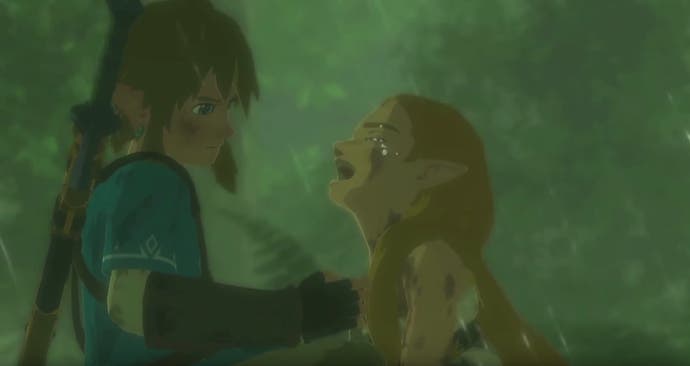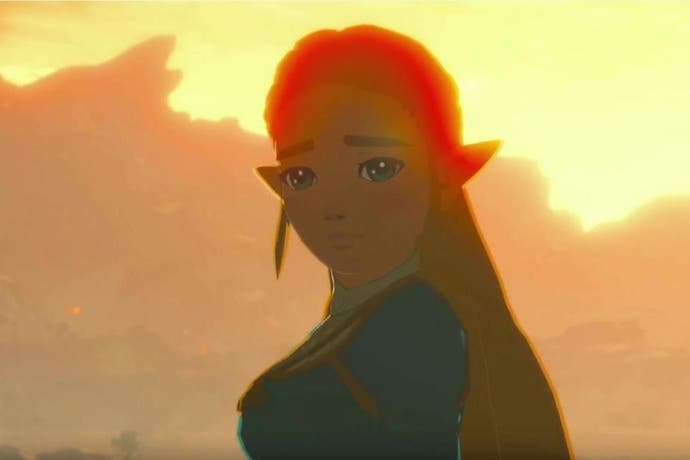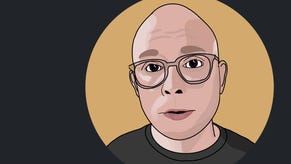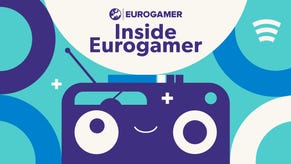The big Zelda: Breath of the Wild interview
Eiji Aonuma on how Zelda made the Switch, and how female Link was briefly considered.
For many, the highlight of last week's Nintendo Switch event was the beautiful new look at The Legend of Zelda: Breath of the Wild, which launches alongside the new console on 3rd March.
It was the first time we had glimpsed some of the game's core elements, our first proper look beyond its starting Plateau, and our introduction to Zelda. Going hands-on with the game again later that day on Switch - even if it was last E3's demo - only confirmed what many had suspected: that this enormous new adventure was going to be the game to get for those picking up a Switch in two months' time.

But, of course, Breath of the Wild was never meant to be a Nintendo Switch game. Its development - first for Wii U, then for Switch as well - has been a fascinating journey to follow. Details have started to emerge about the differences between each version, but questions have remained about how Nintendo has managed to complete such a monumental undertaking.
To answer those questions and many more, Eurogamer sat down for an extensive chat with Mr. Zelda himself, Eiji Aonuma. A veteran designer at Nintendo, Aonuma has acted as director and/or producer for each Zelda installment since Ocarina of Time and acts as godfather to the series.
Read on to hear him speak about handling the "large extra burden" created by the decision to also release Breath of the Wild on Nintendo Switch, what changed during this process, how the game's controls ended up improving - and how his team briefly considered making Link female.
Let's start with the latest Breath of the Wild trailer. I think fans loved what they saw. There were several familiar characters and faces - fans spotted the Deku Tree, for example, and the Koroks. There's continued speculation on where the game might fit within the timeline that we know. Can you expand upon that? Are people on the right track with theories that it follows Wind Waker?
Aonuma: So... in the trailer there was a sort of Wind Waker-esque element, and to a degree you could say that the animation and the art style have some influences from Wind Waker, so I can see why people would draw those connections.
But with Breath of the Wild, one thing I'm really keen to emphasise is that a big part of the appeal of the game is surprise, unexpected encounters, so I want fans to experience surprise and to experience an element of the unexpected - I feel if I spoke too much about that kind of thing, it might spoil things for people, so I'd rather not touch on that too deeply.
Already people have been surprised by what this version of the Zelda series has already brought. Skyward Sword really set down the idea that each version of Link and Zelda were new incarnations of original characters, but with Breath of the Wild, the beginning seems like an attempt to sort of disrupt this and surprise the player by having a Link who's already a hero and has awoken 100 years later. Was it a conscious decision to disrupt the formula and what fans might be expecting?
Aonuma: The fact that Link has been asleep for 100 years is a particularly important part of this story. It's true that this is kind of a technique in a way - a storytelling technique - that we'd like to use this time so everyone can relate to that in his or her own way, and players can discover the importance of that point as they play through the game. How exactly that plays into the story as a whole... well, it's very important, so as you can probably understand I can't really say much more about it at this stage.
This is an idea I've had bubbling away under the surface ever since I started making games.
And that idea relates to the story that players will find out, the narrative of the game?
Aonuma: Yes, and players will discover the importance of that point as they play the game.
I'm not sure if you've already seen, but fans took a close look at the map included with the special edition in America. There are already some theories about what might have happened 100 years ago. Is that something we will see within the game? Either through a flashback, or something that we'll hear about?
Aonuma: Exactly how you'll learn what happened 100 years ago is something I won't say anything concrete about, but I can say that as you play the game, you will learn what happened.
When did your ideas for Breath of the Wild become finalised, how long ago did development begin? And how long ago did the Switch version begin development, too?
Aonuma: In terms of the development of Breath of the Wild, I started thinking about it after Skyward Sword was finished.
With Skyward Sword, the way the game world was set out, the areas a player could explore were actually reasonably limited - you would land from the sky into an area, and then explore that area, but the areas themselves weren't really connected. A lot of people who played the game said to me that they wished they were able to explore the areas between the areas, the gaps between the areas. So that idea of having a large open connected world was in my mind as soon as Skyward Sword was finished, really. And then the Wii U hardware made realising that idea a possibility.
Of course, to actually create that huge open world which you could seamlessly explore, we needed to develop a system for creating that. And actually, just developing the system and tools to create the world, took about a year.
And regarding the Nintendo Switch version, it was spring last year when we made a firm decision to also release on that platform. Obviously that required some adjustments to the development process and changes to be made, and to continue developing the Wii U version alongside Nintendo Switch, that was spring last year.
Can you speak to what kinds of decisions they were? Were they to do with gameplay, how the players interacted with the game, via the Wii U's touchscreen, for example? I'm interested to know the kind of alterations which came up during that decision-making time.
Aonuma: A major consideration at first was the fact Nintendo Switch allows players to play a game on their TV at home, and then to take that with them and keep playing the same game on a handheld device. We felt that was particularly suitable for Zelda, because of the immersive nature of the game, so that was a major consideration for us from the start.
And then obviously because up until that point the development team had been developing it as a Wii U title and making it as comfortable and enjoyable an experience as possible on Wii U, when we decided we'd also develop for Nintendo Switch, we knew in a way we would be placing a large extra burden on the development team. And I knew some would complain about it, as they'd been developing it for Wii U and they'd have to make some changes, but I really led that process myself - I really thought myself about how we could make that title work on Nintendo Switch, and had to sell the idea to the development team, in a way.
Obviously a major difference between developing for Wii U and a major thing we had to change for Nintendo Switch was the controls. Wii U has the Wii U GamePad, and we originally envisaged making major use of that for the controls. Of course on Wii U you have two screens - the main screen, and one on the GamePad - but the Nintendo Switch has one screen. That was a major change, but we achieved it a lot more easily and quickly than we expected. In the end we're happier with how the controls came out, having made those changes. I feel that the control system we landed on was better than what we originally had.
Playing the game last week, the controls felt great on Switch. The Sheikah Slate looks a bit like the Hyrule version of the Wii U GamePad, and looks like it could be controlled in that way - was that the intention?
Aonuma: Yes, initially that's true - we kind of pictured the Sheikah Slate as being reminiscent of a Wii U GamePad, but also to be honest with you I think the Sheikah Slate's size and appearance resembles a Nintendo Switch quite strongly. So we think that comparison works for both versions of the game, and we're happy with it.
And the fact we didn't have to change the appearance of the Sheikah Slate in game... we were very grateful for that.
I know a couple of people who will play on Wii U, and more people who will play it on Nintendo Switch. Fans have been wondering what the differences are between the two versions, other than it looking slightly better on Switch. Are there any gameplay differences, or has it been developed to offer the same experience on either platform?
Aonuma: Actually from a gameplay perspective, it is the same experience on both platforms.
One small difference is that the loading times on Nintendo Switch are slightly faster. That really stems from the media that the game is on - on Wii U it loads from a disc, whereas on Nintendo Switch it's on a Game Card, so it's a result from that.
Did you ever consider only releasing Breath of the Wild on Switch, or was it important for fans of Wii U to still have the game released on that console?
Aonuma: No, we never considered not releasing the Wii U version, and changing development solely to Nintendo Switch - that was never on the cards. As I mentioned, this title started development as a Wii U title, so first and foremost we started it on Wii U. After we also decided to develop for Nintendo Switch... if we'd gone more in that direction, using Nintendo Switch console's other features that Wii U doesn't have, we felt that a gap might have opened up in terms of the experience between both platforms.
With Nintendo Switch we're really happy with that functionality of being able to take it wherever you go, but beyond that we really wanted the gameplay experience to be the same, and for Wii U fans to be able to experience the same game people who play it on Switch will be able to experience.
It sounds like a major undertaking and development - it's a massive game you're releasing across two different platforms. I'd love to know the challenges of creating such a big game and making sure that it was done in time for the launch of Nintendo Switch.
Aonuma: Yes, this was a development process where on numerous occasions we've had to say, "Sorry, we need more time", and because the process was so long there were actually a lot of problems that got naturally resolved over time.
One of the major problems we faced on a game of this size was actually coordinating everything, and by that I mean creating this huge open world by lots of development staff. Each individual person might be working on just one part of that world, but if they're working without a broader context, within isolation, then they might think, "I'm creating this particular area or feature or object", but if they don't know how that fits into the broader world and context of the game, things won't tie together very well.
We had to make sure everyone was communicating as much as possible, and everyone had an idea of that broader world, but we really had to make sure all the development staff could play the game as much as possible. That takes a long time for a game of this size as you can imagine. So we had to take time throughout the development period to really play the game and make sure that this cohesion was maintained.
Another example of a challenge we faced was the physics engine. We wanted a consistent physics engine throughout the world that worked in a logical and realistic way. Actually implementing that was sometimes more complicated than it seemed. [For example], one day I picked up the latest build of the game and went to an area, and saw that all the objects that were supposed to be in that area weren't there. I was quite surprised and confused, and I realised after asking the programmer, the reason the objects weren't there was because the wind in-game had blown them all away.
That's the kind of challenge we faced, making the physics engine realistic, but not to the extent that it would negatively impact things - striking a balance between realism and having it work within the game world.
I really think the implementation of this physics engine is a major development for the Zelda series. The way the physics engine underpins everything in the world really offers up a lot of new possibilities. For instance, in Breath of the Wild you might have a puzzle where making use of the physics, there'll be various ways you can solve that puzzle. That really opens up a lot of possibilities so there's not just one way to progress in the game or just one way to solve a puzzle.
How important was it to have Breath of the Wild finished in time for the Nintendo Switch launch? Did you ever feel like it just wouldn't be ready in time?
Aonuma: In terms of the schedule, as you know there were a few times during development we had to say, "We're sorry, we need more time", and we were lucky that we were allowed to have that time. And we're very grateful for that. But as soon as the development of the Nintendo Switch version became a reality, we knew we would be releasing it at launch of the Nintendo Switch. So that deadline was something we knew about from a while ago, and knew we'd be able to hit that deadline.
In terms of the importance of having it at launch... my boss is Mr Koizumi who's the main producer of the Nintendo Switch (hardware) so for me personally it was very important!
This isn't just a big game, it's also a game with the added challenges of localising and translating vocal dialogue for the first time in a major way in a Zelda game. I'd love to know how you dealt with the challenges of getting it all ready to launch at the same time, especially here in Europe where we have quite a few languages to deal with.
Aonuma: It's true that as you say, particularly in Europe with its different languages, it is a big challenge to localise a game of that size with voice acting in particular. But always, from previous titles in the series, actually being able to allow fans to experience The Legend of Zelda in their own language is something we really care about and something we've regarded as an important thing to achieve. Of course we have our localisation processes in place and having talented staff to work on that was very important, and we're very happy to have achieved that goal, so Zelda in various different languages will be a reality for fans when they play the game.
Going back to where we started, and the new footage, let's talk about Zelda. Fans seem to love her design in Breath of the Wild - there's already a lot of fan art. But reaction seems split on her crying during the trailer, with some saying it demonstrates a lack of strength, others saying it's good she's showing emotion. I wondered what your take on that was.
Aonuma: Regarding how Princess Zelda is portrayed in the trailer, obviously everyone has their own ideas of exactly how they would expect a female character to act or behave. What I would particularly like to emphasise is that the scene of her crying in the trailer is just one scene from the game - within the trailer itself it forms a dramatic high point, but that shouldn't be taken too much out of context.
Princess Zelda as she appears in the game as a whole is very complex and multi-faceted, and it's not as if she's crying all the time in the game [laughs], so I would ask fans not to read too much into just that one scene from the trailer, and to please play the game and appreciate Zelda as she is in all her aspects.

Zelda fans continue to show interest in having Zelda as a playable character, and I wonder if that was something that was considered for Breath of the Wild?
Aonuma: I seem to remember three years ago when we showed the first trailer at E3, I said something along the lines of "I never said that Link would necessarily be male" or something along those lines, and that got taken out of context and turned into a rumour that took on a life of its own. Link has always been portrayed as a male character as the protagonist of the games.
After that happened actually, we did discuss in the team about whether or not we should have a female protagonist. I spoke to Mr Miyamoto about it and the whole team talked about it, but in the end, it just didn't happen.
On Wii U of course there's already Hyrule Warriors where Princess Zelda is a playable character, and there's actually quite an assortment of characters including several female ones. And that title is already available of course. So looking to the future, talking about the possibility of having a playable female protagonist, I'd say yes, it's a possibility.












